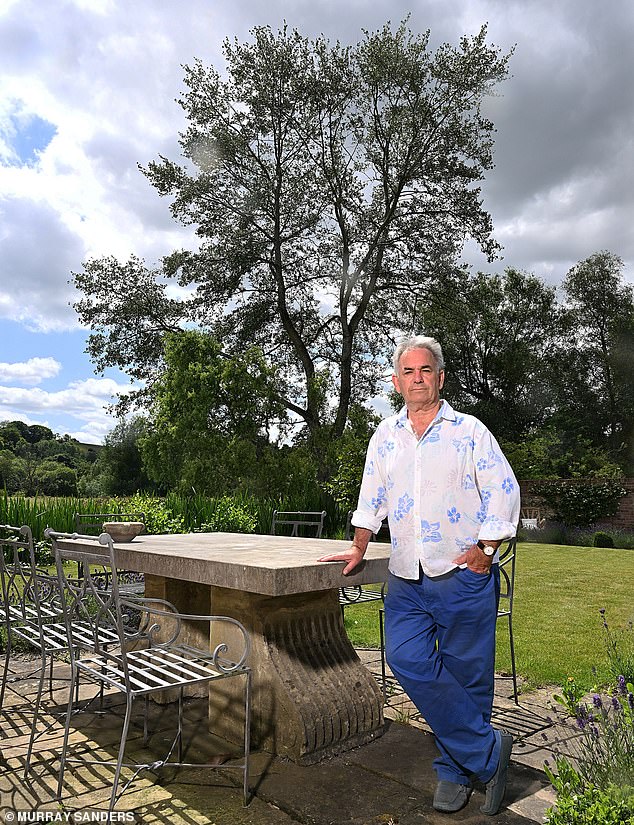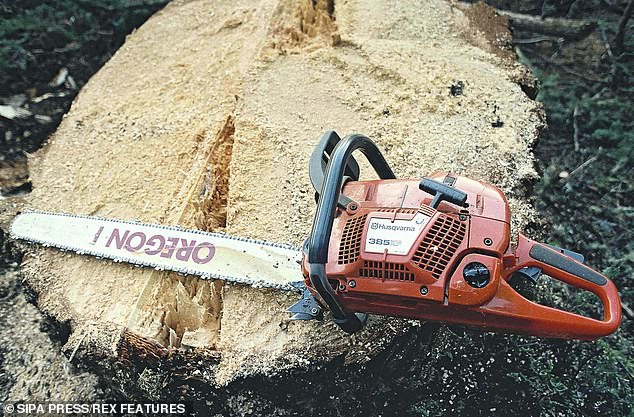The blackbird who has made his home in my garden has become something of a friend.
He potters about on the grass in search of worms immediately after I’ve finished mowing and takes a keen interest whenever the compost heap is turned over to reveal all kinds of nutritional goodies.
More generally, he watches proceedings from a branch of the 50-year-old grey poplar tree and bursts into song with bravado.
The tree belongs to new neighbours, who have bought the house a few doors away.
It stands in the water meadow – part of a flood plain – across from the Kennet Stream which joins the River Kennet at the far end of Ramsbury, a village of around 2,000 people in Wiltshire.
Parts of the water meadow are owned by different people – the section where the tree stands is owned by my neighbours who want to cut it down.

An un-poplar decision? Mark is fighting to save the 50-year-old grey poplar tree in his neighbour’s garden
The problem for Mr Blackbird and myself is that the grey poplar – which is more than 150ft high – is due to be felled by our neighbours because it obstructs their view of the meadow and what’s known as Spring Hill, which rises up behind it.
I understand their reasoning and there has been no unpleasantness between us, but I am surprised that such a beautiful, mature tree such as this can be chopped down so easily.
And it is beautiful. Its thick, silvery trunk divides into three equal sections about 30ft from the ground and then dozens of branches and sub-branches reach for the skies.
The leaves flutter, creating an almost strobe-lighting effect, and when the prevailing south-westerly blows, the sound is akin to the sea washing up on a sandy shore. Gentle but determined – and forever calming.
Most of the gardens in the street fall within a conservation area, meaning that if the grey poplar was in our neighbours’ garden, a licence from Wiltshire Council would have to be granted to remove it.
I checked this with our parish council and established that although the water meadow, where the tree stands is designated an Area of Outstanding Natural Beauty (AONB), there are no tree restrictions on such an area.
Which sounds like a contradiction in terms. An AONB is more to do with stopping development rather than saving trees.
A friend in the village told me that the only chance of granting the tree a stay of execution was by applying for a Tree Preservation Order (TPO) – and I was confident about achieving this, not least because of the outpouring of anger and sadness following the horrific felling of the Sycamore Gap tree at Hadrian’s Wall.
If there was any silver lining to that ‘moronic act’, as the judge put it, perpetrated by the two men who were found guilty of chainsawing the 150-year-old sycamore two years ago, it was that it focused minds on the importance of trees and the impact they have on our well-being.
So I pressed on. The process of seeking a TPO was painless. The council gave me the name and email of the ‘Arboricultural Officer’, who in turn requested a site plan to show the location of the tree, photos and a statement as to why it should be preserved.
In terms of the latter, I reminded him that poplars are excellent at phytoremediation, the process of absorbing and degrading contaminants in soil and groundwater – an important point when a tree is on a flood plain.
I also added a dash of emotion by saying that a neighbour, who has lived all his life in sight of the tree, can’t bring himself to tell his partner about the plans to fell it because she will be too upset.

Threat: Most of the gardens in Mark’s street fall within a conservation area, meaning that if the grey poplar was in his neighbours’ garden a licence would have to be granted to remove it
The Arboricultural Officer duly came to look at the tree. He later phoned and explained that under the Town and Country Planning Regulations 2012 a key consideration is ‘visibility’, specifically that a tree ‘should normally be visible from a public place, such as a road or footpath, or accessible by the public’.
Unfortunately, although you can see the top of the tree from the High Street and see most of it from a public footpath, not enough of it is visible in the former case and it’s too far away from the footpath. My application, therefore, was rejected.
‘There are quite a few loopholes in the current legislation,’ said Jack Taylor, from the charity Woodland Trust.
‘It seems strange that such an emphasis is put on the amenity value of a tree and not its beauty and contribution to the ecosystem. Just because lots of people can’t see a tree doesn’t mean it should not be protected.’
But all is not lost. I knocked on the door of my neighbours, who own the tree, and simply told them what a lovely specimen it is and how it would be greatly missed. They listened politely.
And three weeks later, the tree is still there – and I might be imagining this, but I sense that the blackbird is singing louder and merrier than ever.













